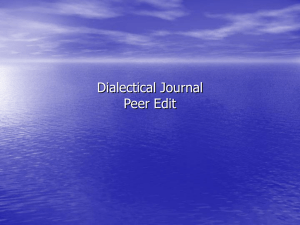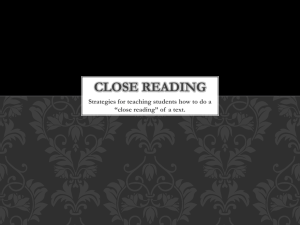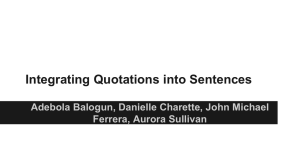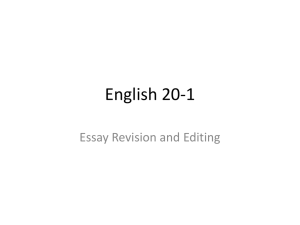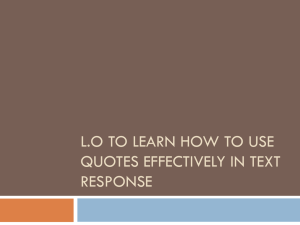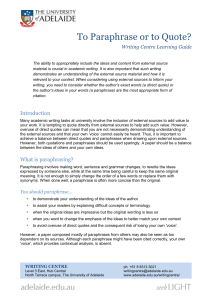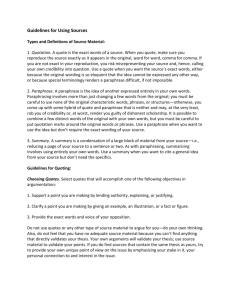Handling Quotes Fairly and Accurately
advertisement
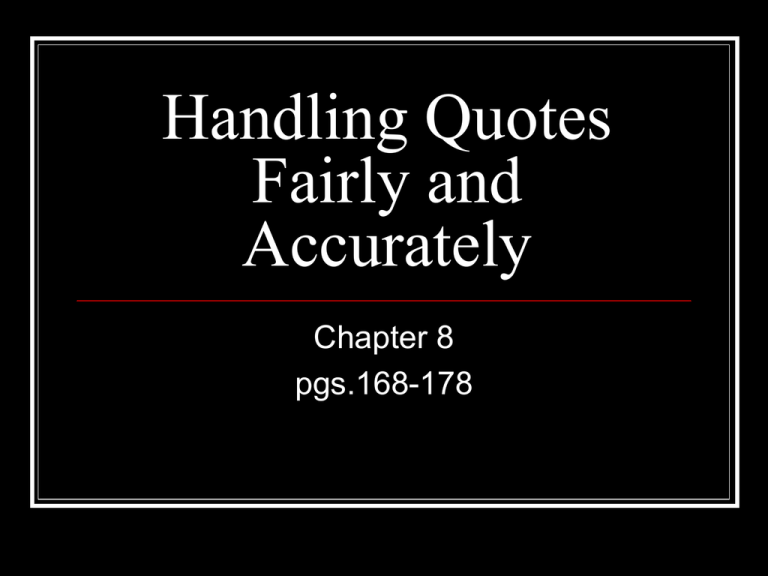
Handling Quotes Fairly and Accurately Chapter 8 pgs.168-178 Quotes from Tom Osborne “It wasn’t a ho-hum thing, but our players were confident they’d win tonight.” “I think the players expected to win. It wasn’t ho-hum. But it was matter-of fact.” “I certainly didn’t think it would be a blowout.” “I didn’t think it would be a blowout.” Quotes from Tom Osborne “I guess there’s still a place in college football for a running quarterback. The option still has a place in football.” “This does point out the fact that there is still a place in college football for a running quarterback. We believe there is still a place for the option.” What do you think is wrong? At least one of the quotes in each pair has to be wrong. The coach could not have both quotes attributed to him. Does it matter? Do direct quotes have to be word for word accurate? Is there no margin for error? What does this mean? The changes in what Osborne said were quite harmless—but they are still bothersome. The world doesn’t really care if a word or two is different in this case, but 100 percent accuracy is always the goal. Direct Quotation As a beginning journalist, you should pay close attention to the skills involved in handling quoted material. When you enclose a sentence or part of a sentence in quotes, you are telling your readers that the words are exactly what the speaker said. This is seldom if ever reached. Direct Quotation When people are speaking extemporaneously, they say things like “ya know,” “hmmmm,” “ahhhh,” etc. You wouldn’t want to copy speech exactly. The most important thing is to convey their information—there is no information in “ya know” A question of exactness Most sources don’t care if they are quoted exactly—they care that their thoughts and ideas are conveyed accurately to the public They do not care about their exact words. Does this mean that journalists can just come close? NO—you should always try to be 100 percent accurate, especially in certain circumstances. Using a tape recorder Can be a great help when capturing someone’s exact words is important. If the source agrees, you may use the tape recorder. It is sometimes good to use a recorder during speeches and meetings. Remember to still take good notes! When Not to Quote There are exceptions to using exact quotes-quoting a 4-letter word is a good example. There’s also no need to reproduce bad grammar-unless it is part of the person’s character and would change you story if you didn’t. Paraphrasing Often paraphrasing is helpful. It is perfectly alright to paraphrase a person’s words: to put the speaker’s ideas into the reporter’s own words. So, if a direct quote is long or rambling or poorly stated, the writer may revise it, knock off the quote marks, and simply add “he said” or “she said” at the end of the sentence. Example “We are doing everything in our power at police headquarters to see to it that there is a parking place for everyone who drives to school. We hope everyone involved will be patient. We’ll work it out, I promise.” This can be paraphrased: Paraphrase of quote from Chief Jones Chief Jones said police are trying to find parking space for everyone at school. He urged patience and promised to find a solution for the crowded lots. Some words must be changed Example: “We decided to go to a movie” must be paraphrased “They decided to go to a movie” Always say the country, the school, the town, not our country, our school, our town. Writing in first person injects the reporter into the story; it amounts editorializing into a story. Paraphrase for Facts Quotes should not be used to convey facts. Quotes make a story lively, give it a human touch, let readers begin to understand what a source is like. Capture good quotes and use lots of them. But paraphrase when you’re simply conveying facts. Avoid Repetition Do not present the same information as both a paraphrase and a direct quote. Example: The mayor promised today he would never embezzle money from the city again. “I will never embezzle money from the city again,” the mayor said. Partial Quotation One method to avoid the overuse of both paraphrased material and long blocks of quoted material is the partial quote. A writer is free to directly quote part of a sentence while paraphrasing the rest. The school needs a dress code, the principal said, because the students are becoming “sloppy in dress and sloppy in thought.” Partial Quotation Beware that you do not carry this practice to absurd extremes. Jones said he was “happy” after scoring the touchdown. These quotes add nothing but confusion. These are not quotes that are quoteworthy. Attribution Since it is not possible to really know what people mean or feel or believe, report what they say they mean or feel or believe. Report what the person said and make a point of saying who said it. Examples: The superintendent said she will resign. The police chief said Jones had confessed. Attribution The verb you use to indicate your source is important: stated, declared, noted, pointed out, and so on. The BEST word to use is said. It is neutral and contains no editorializing and rarely becomes tiresome no matter how often it appears in a story. Words to Use Be careful which word you select when you don’t use said. Stated is very formal Pointed out should be reserved for absolute facts. Charge, demand, shout, and other words like that have editorial connotations. Need for Attribution When you need attribution, where should you place the “he saids” and the “she saids.” In general they work best at the end or in the middle of a sentence. In a long quote, attribution should come at the first logical point in the first sentence. Example: “Our students are mature,” Kuzinski told teachers Tuesday, “but they do not always act like it.” Checklist for Interview Story Is the person being interviewed identified at the beginning of the story? Is the story a mix of text and interesting , relevant direct quotations? Are paraphrases used in place of rambling speeches and lists of facts? Are all important, controversial, or opinion-based statements clearly attributed? Is the story free from grammatical errors and does it follow the AP stylebook? Assignment As ten students you do not know well for their opinion on a school issue, or an issue that relates to students. Write a story suitable for publication, quoting all students correctly. By the end of the block, have your topic selected and your questions written. By Wednesday, have your interviews completed.
